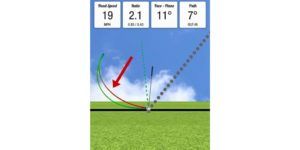
One of the most frustrating things for a golfer is to fail to get on the green with a wedge in your hand. You’re so close, and you just can’t get it on!
There isn’t a golfer on the planet that is immune from these issues, even at the pro level.
If I had to pick one thing that causes many of these mishits it would be deceleration. Sometime before impact we say to ourselves “oh no slow down!!!” and the club fails to make proper contact.
This isn’t an issue that ever gets solved completely because if you watch a PGA Tour event on any given weekend you will see plenty of guys leaving chips woefully short of the green because they decelerated.
However, we can get better and make it happen a little less often.
That to me is progress in golf, getting incrementally better. Telling yourself you have solved something forever is a guaranteed way to disappoint yourself. Golf is always changing on us.
It’s quite simple
I believe for some players the key to improving at these delicate wedge shots is to shift your focus away from what your hands and arms are doing. Golfers get so caught up in the minutia of their technique that they often let these parts of their body dictate the shot. As a result they forget one of the most important things necessary to hit consistently good wedge shots.
It’s rotation.
One of the key engines of a great chip or pitch shot is the rotation of your body. If you can let the rotation of your body help dictate the shot, rather than your arms, I believe you will be more successful.
Think of it as if the club and your arms are just along for the ride, rather than being behind the wheel.
I once heard Nick Faldo talking about this on a broadcast. He said that when the pressure was really on, and he had a delicate wedge shot, he would solely focus on making sure he rotated through the ball with his body to avoid a mishit.
When you use your arms and hands too much they tend to start the downswing, and eventually they lose momentum at impact because your hips have not rotated one bit.
That’s where deceleration comes from mostly. You get stuck, and the momentum of the club head slows down at the most important moment.
One of the best ways to track if your body is rotating is to think of what your belt buckle is doing. If you’re decelerating it’s most likely moving back a little bit, and then not doing much more afterwards once you have started your downswing.
At the minimum you want your belt buckle pointing somewhere in front of the golf ball when you’ve completed your chipping or pitching motion. For someone who has a real issue with deceleration it might make sense to exaggerate your follow through to really cement the feeling.
A little help from technology
It’s difficult to figure out when and where you are decelerating around the greens. I did an experiment the other day at my golf course that helps me visualize things a bit more.
I used my Swingbyte to track all of my chip and pitch shots around the green, and analyzed the results afterwards. I took note of the shots where I didn’t make crisp contact and felt that I had decelerated. I found out some interesting things.
Swingbyte has a feature where it tracks the acceleration of your club in their 3d rendering and shows where your club is speeding up and slowing down, indicated by different colors.
If you take a look at my better wedge shots you can tell that the red line was focused more around impact, meaning I was speeding up a bit more as I got closer to the ball, which is what you want.

On the shots where I had mishit the ball it was all the same. You can see that I started accelerating too much right around the transition. It is also worth noting that my swing speed was about 30% slower on the shots where I decelerated.

A Drill to Work With
I found a great video that explains this even further, and gives you a drill to help fix this issue. The instructor gives a nice analysis of what happens when your body stops rotating.
Try out this drill, and if you really want to start tracking your progress on shots like these (and many others), a swing analyzer can help if you use it properly. Swingbyte has been nice enough to give users of the site a coupon code for $30 and free shipping. Use code 'practicalgolf' at checkout when you purchase at www.swingbyte.com.
We care about the protection of your data Read our Privacy Policy